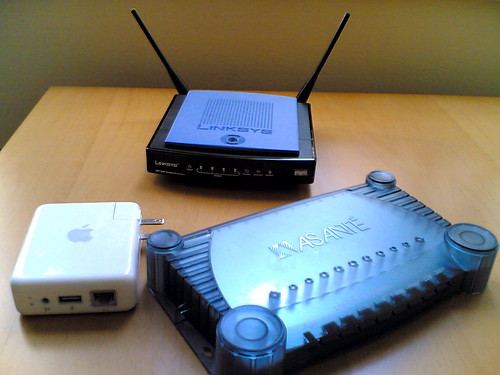I’ve been making comments here and there about our home network for the past few weeks, and it all came to a head about a week ago. At first, I was quick to blame Shaw about their service and lack thereof. I know for a fact that there was one day where it was their fault that we had no access for nearly a day, but the problems continued after a quick phone call about the problem.
For the past few years, I’ve been using an Asante FriendlyNET FR3004 router (circa 2002) and an Apple Airport Express to create a wired and wireless LAN. Not even a year after buying that Asante of an eye sore, it was discontinued, and the firmware updates stopped not long after. The UI for setting up the thing was never my favorite, but it worked. Well, it worked until about a week or so ago, and the Apple Airport Express has always worked well, now a very handy, travel-sizable WiFi device.
During a recent recording of The Crazy Canucks that ended up being a hodge-podge selection of material due to technical problems, our network went into meltdown. Skype wasn’t working, and the entire bandwidth ground to a halt after that. This was prefaced with slow performance in the days leading up. It wasn’t until that I bypassed the router and went straight into the iMac that the Asante was medically discharged from service.
After some research, Rebecca and I settled on getting a new router. Like my father raised me, I didn’t want to get something that would work as much as it would be a suitable replacement for at least the next three years. Looking at the specs for the WRT150N, it had a few key things that I wanted; four 100/1000 Base-T ports on the back, WPA wireless encryption, and 802.11n capabilities that would support Rebecca’s MacBook.
There were some folks recommending other versions of Linksys routers, namely Duane and Gregg, and those were very much appreciated. For the price and the performance that I’m getting now compared to what I had is very noticeable and quite loved though, and it makes me very happy. I used to think that my PowerBook’s performance over wireless was poor due to it’s age, but it was obviously the poor operation of the old router translating traffic to the Apple Airport Express. It’s nearly a new world, and Rebecca has noticed it as well.
So far, I’m really impressed with the Linksys WRT150N. I spent some time setting it up to allow better functionality with certain programs like iChat or Skype, and the wired connection for the iMac has an increase in performance when loading websites or downloading podcasts. Here’s hoping for the long term, but knowing the interesting things I could do with other Linksys models makes me wonder what other, geeky things I could do with it. I’d just have to brave to try.


My Airport Extreme can beat up your Linksys 😉
Seriously though, I hope Linksys has improved their firmware as my 6 month old WRT54G (with the latest firmware) would choke all the time because it was bad at dealing with bittorrent traffic – too many open connections that wouldn’t expire correctly would cause it to do the equivalent of a toilet backing up.
It’s now in a box waiting to be hacked or blown up or both. It was replaced with a pre-gigabit Airport Extreme which is great since it has the USB port for external hard drive NAS support.
I think you made the right choice. The WRT54G I’m currently using suffers from exactly what John (1st comment) mentioned.
I can’t wait to replace it.
What I had recommended to John (well… more Twittered it and hoped he spotted it) is that if he was thinking of going with the WRT54G, then he should get the WRT54GL instead. After version 4, the WRT54G was dummied down with less memory and a simpler firmware than the original Linux based version. The lower memory keeps it from being able to run Linux and also causes issues such as too many open connections crashing it. The demand for the original versions was so great that they re-released it as the WRT54GL, with the “L” indicating Linux capable (has the extra RAM necessary). I was looking for a cheap solution 6 months ago, and the WRT54GL was well worth the extra 8 dollars over the non-L version. I then dumped the Linksys firmware in favour of an open source firmware.
Good choice John, what you grabbed is certainly would have been a consideration if I had a bunch of wireless devices.
My decision was really between the Linksys WRT54G and WRT150N because of what Duane was telling me here:
http://duanestorey.com/blog/2007/07/08/wrt54g-wireless-router/
The WRT150N was totally in my price range, and as I did want the Airport Extreme, for just under half the price, I grabbed the Linksys. Plus, I have four ports on the back opposed to the three on the Airport Extreme. Some days, you just can’t beat the bandwidth you get from a hard wired connection opposed to wireless. 🙂
I like the idea of toying with the firmware via open source tools, but I’m pretty happy with the setup on this router. Plus, the last thing I need to do is hose myself with trying to set up something in Linux and muck everything up.
Looking forward to seeing how things go on the WRT150N in the future, John. I too had issues with my WRT54G and opted to install one of the open-source firmware pagages called DD-WRT earlier this year to improve the performance and get the proper control over the router’s settings.
Things have worked out much better with the router, it’s absolutely rock solid since the change which means that the Linksys hardware should be pretty reliable. Keep us posted in a few months and let us know how it is. 🙂
I just bought the WRT150N, for some reason I can’t see my other computer in My networks Previously I had a old netgear and was able to share the printer and computer… once the WRT150N was installed all of this stopped.
Hi folks!
I just bought my macbook pro and a wrt150n, but the cd does’t run in macs. Where can I find a compatible setup file to macs or what else can I do? A pc laptop runs good with wap or wep security but my mac does’t accept my password, but I can connect with no password at all. I appriciate any help. Thanks!
Patrick – you can use the web based GUI to setup the router. Read the documentation that came with it or check out the Linksys site. I also hear that they have some decent tech support, but you take your chances when you do that.
Dave – You might have to enable some ports to get the printer sharing to work. Firewalls have to have holes poked into them so you can get certain services to work.
Hearing that you have gotten your Apple & your wrt150n to play well together makes me sad. I have spent 4 hours on tech support & I finally gave up and removed the security. I would be on the wireless for 3 minutes, it would drop me and then I either couldn’t find the connection or it wouldn’t connect. If you have the settings handy that I could use to make my connection happy and can send them you would be my hero. Linksys said I had a bad router yet my husband’s PC works just fine. Sad Apple user.
hi, just asking a question that i cant seem to get any help on. I bought a WesternDigital External Hard drive and plugged it into my Linksys WRT150N Wireless Router, but I cant get the harddrive to show on my other computers in the network. Sorry to bother you with the problem, I just have no idea about where to get this working and it might not even be a router problem…any help would be great!
I have a new mac pro and after finally getting the airport extreme card connected properly (failed to attach the antennas the first time). I can successfully connect to the router using WEP2 personal encryption. Unfortunately I can only see the internet and can not see any of the other windows based PC’s on my network. Has anyone run into and solved this problem?
Tina… I had a similar problem prior to the Mac and set the radio band to 40 the channel to 9 and the standard channel to 11. It was home interference (wireless phones, cell phones, micro waves…etc that seemed to be causing the issues).